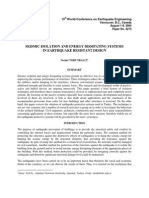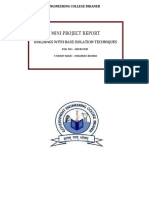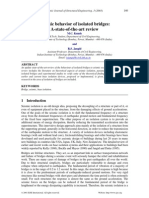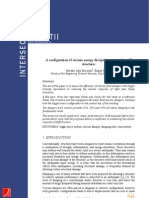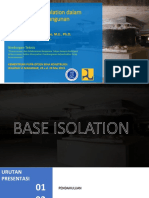Base Isolated Structure A Review IJERTCONV4IS03036
Base Isolated Structure A Review IJERTCONV4IS03036
Uploaded by
Shivam SrivastavaCopyright:
Available Formats
Base Isolated Structure A Review IJERTCONV4IS03036
Base Isolated Structure A Review IJERTCONV4IS03036
Uploaded by
Shivam SrivastavaOriginal Title
Copyright
Available Formats
Share this document
Did you find this document useful?
Is this content inappropriate?
Copyright:
Available Formats
Base Isolated Structure A Review IJERTCONV4IS03036
Base Isolated Structure A Review IJERTCONV4IS03036
Uploaded by
Shivam SrivastavaCopyright:
Available Formats
Special Issue - 2016 International Journal of Engineering Research & Technology (IJERT)
ISSN: 2278-0181
RACEE - 2015 Conference Proceedings
Base Isolated Structure: A Review
Isha Verma
Civil Engineering Department
University Institute of Engineering & Technology
MDU, Rohtak-124001, India.
Abstract- The structures constructed with good techniques and inception and except few buildings like hospital building at
machines in the recent past have fallen prey to earthquakes Bhuj, experimental building at IIT, Guwahati, the general
leading to enormous loss of life and property and untold structures are built without base isolation techniques. Many
sufferings to the survivors of the earthquake hit area. Base significant advantages can be drawn from buildings provided
isolation concept was coined by engineers and scientists as early
with seismic isolation. The isolated buildings will be safe
as in the year 1923 and thereafter different methods of isolating
the buildings and structures from earthquake forces have been even in strong earthquakes. The response of an isolated
developed world over. Controlling seismic behaviour is possible structure can be ½ to 1/8 of the traditional structure. Since the
only through faithful design that ensures all behavioural actions super structure will be subjected to lesser earthquake forces,
considered in buildings during analysis. In keeping with the key the cost of isolated structure compared with the cost of
characteristics of buildings, structural design of buildings can be traditional structure for the same earthquake conditions will
stiffness-based, strength-based, deformation-based and energy- be cheaper. The seismic isolation can be provided to new as
based. In this paper a review has been done for the base isolated well as existing structures. The buildings with provision of
structure with different techniques, parameters and isolators can be planned as regular or irregular in their plan or
components.
elevations.
Keywords: Earthquake, Base isolation, Stiffness, Deformation
A. Base Isolation Techniques
I. INTRODUCTION The seismic energy forces entering the structure can be
controlled by two basic approaches:
The destruction caused by an earthquake is highly a) Structural Design that can accommodate the input seismic
unpredictable and sometimes beyond repair. Though it is not energy.
possible to avert this natural disaster, but it is possible to b) Isolate the seismic energy to reduce or divert it, before it
minimize and reduce the effect caused by it. Innovative enters the structure.
methods of seismic analysis of structures play an important Seismic isolators function based on the second approach,
role in its mitigation. The loss of life and damage to property in which energy is limited by using energy absorbing or
due to the disaster can be reduced by adoption of improved dissipating devices. These devices isolate only horizontal
prevention and preparedness measures. This is usually forces. These isolators come in various shapes, forms and
accomplished by using permanent controls i.e.; structural or sizes (The Hartford loss control department, 2002). Seismic
non- structural designed and developed [Housner, G.W. et al, isolated structures are currently difficult to analyze, design
1997] in advance of the disaster or by using temporary and implement due to complex code requirements. Base
measures. isolation is an approach to earthquake-resistant design that is
One of the most widely implemented and accepted seismic based on the concept of reducing the seismic demand rather
protection systems is base isolation. Seismic base isolation than increasing the earthquake resistance capacity of
[Skinner et al. 1993; Naeim and Kelly 1999] is a technique structure. This technology was first developed for bridge
that mitigates the effects of an earthquake by essentially construction to protect against thermal movement in the
isolating the structure and its contents from potentially bridge deck. Isolators are of many types depending upon their
dangerous ground motion, especially in the frequency range sizes, shapes and advantages. They can be elastomeric based
where the building is most affected. The goal is to systems, high damping natural rubber systems and sliding
simultaneously reduce interstory drifts and floor accelerations systems etc.
to limit or avoid damage, not only to the structure but also to The isolation mechanisms are designed so that only a
its contents, in a cost-effective manner. small portion of the energy of the earthquake is left to be
Base isolation concept was coined by engineers and dissipated by the super-structure. Elastomeric bearings and
scientists as early as in the year 1923 and thereafter different frictional sliding mechanisms installed in the foundations of
methods of isolating the buildings and structures from seismically isolated structures are some of the examples of
earthquake forces have been developed world over. Countries seismic isolation systems which protect the structures from
like US, New Zealand, Japan, China and European countries strong earthquakes through a reduction of stiffness and an
have adopted these techniques as their normal routine for increase in damping. The purpose of this paper is to provide a
many public buildings and residential buildings as well. brief overview of many new technologies that are rapidly
Hundreds of buildings are being built every year with base becoming more prevalent in the seismic design of structures.
isolation technique in these countries. All these technologies involve the use of specific devices to
As of now, in India, the use of base isolation techniques alter or control the dynamic behavior of buildings.
in public or residential buildings and structures is in its
Volume 4, Issue 03 Published by, www.ijert.org 1
Special Issue - 2016 International Journal of Engineering Research & Technology (IJERT)
ISSN: 2278-0181
RACEE - 2015 Conference Proceedings
II. ENERGY DISSIPATION DEVICES [K.K Walsh; M.M. Abdullah, 2006] of structures. It used
novel variable amplification devices (VAD) connected in
The structural systems that utilize seismic isolation series with a passive damper. The VAD is capable of
technologies can be broadly categorized as passive, active or producing multiple amplification factors each corresponding
hybrid control systems [Kelly, 2001; Naeim and Kelly, 1999; to a different amplification state. To demonstrate the
Skinner et al., 1993]: effectiveness of VAD damper, numerical simulation
(1) Passive control systems: These systems are designed to conducted for three and seven storey base isolated building.
dissipate a large portion of the earthquake input energy in The results indicate that the system can achieve significant
specialized devices or special connection details that deform reduction in response compared to the base isolated buildings
and yield during an earthquake [C. Alhan, H.Gavin, 2003]. with no damper. The proposed system was also found to
Since the deformation and yielding are concentrated in the perform well compared to a typical semi active damper.
device, the damage to other elements of the building is (2) Active control systems: These systems provide seismic
reduced. These systems are passive because they do not protection by imposing forces on a structure that counter
require any additional energy source to operate and are balance the earthquake induced forces. These systems are
activated by the earthquake input motion. Seismic isolation active in the sense that they require an energy source and
and passive energy dissipation are both examples of passive computer-controlled actuators to operate special braces or
control systems. Generally, these devices are used at the base tuned-mass dampers located throughout the building. Active
of a structure as a part of an isolation system or in systems are more complex than passive systems since they
combination with braced frames or walls as energy rely on computer control, motion sensors, feedback
dissipation devices [M. D. Symans et al, 2008]. mechanisms and moving parts that may require service or
A study was made on isolation system consisting of maintenance.
Sliding Teflon bearing and displacement control devices for (3) Hybrid control systems: These systems combine features
seismic protection of bridges [M.C. Costantinou et al, 1991]. of both passive and active control systems. In general, they
The system utilizes multidirectional Teflon bearing for have reduced power demands, improved reliability and
accommodating thermal movements and for providing the reduced cost when compared to fully active systems. In the
isolation mechanism and displacement control devices which future, these systems may include variable friction dampers,
exhibit bilinear behaviour with controlled stiffness and variable viscous dampers and semi-active isolation bearings.
characteristic strength. The devices provide rigidity for
service loads below their characteristic strength and restoring III. RESEARCH WORK ON BASE ISOLATED
force and energy dissipation for strong earthquake forces. TECHNIQUES
a) Seismic isolation systems: The objective of these systems
is to decouple the superstructure from the damaging Base isolation is an area in the field of passive vibration
components of the earthquake input motion i.e. to prevent the control of the structure, which attracted lot of researchers to
superstructure of the building from absorbing the earthquake explore it. Practical systems for earthquake base isolation
energy. The entire superstructure was supported on discrete began to appear in the last quarter of the 20 th century. Seismic
isolators whose dynamic characteristics were chosen to isolation research in the middle and late 1970s was largely
uncouple the ground motion. Some isolators were also predicated on the observation that most strong-motion
designed to add substantial damping. Displacement and records recorded up to that time had very low spectral
yielding were concentrated at the level of the isolation acceleration values (2 sec) in the long-period range. Records
devices and the superstructure behaved very much like a rigid obtained from lakebed sites in the 1985 Mexico City raised
body. concerns of the possibility of resonance, but such examples
A study on 3D nonlinear analysis procedure of base were considered exceptional and predictable. One of the early
isolated building [Deb, Sajal Kanti, 2004] discussed the (i) examples of the earthquake design strategy is the one given
effects of soft soil on performance of base isolated building, by Dr. J.A. Calantariens in 1990. It was proposed that the
(ii) effects of near fault motion, and (iii) soil-base isolated building can be built on a layer of fine sand, mica or talc that
building interaction. would allow the building to slide in an earthquake, thereby
(b) Passive energy dissipation systems: The objective of reducing the forces transmitted to building.
these systems is to provide supplemental damping in order to A detailed literature review of semi-active control
significantly reduce structural response to earthquake systems Michael D. Symans et. al (1999) provides
motions. This may involve the addition of viscous damping references to both theoretical and experimental research but
through the use of viscoelastic dampers, hydraulic devices, concentrates on describing the results of experimental work.
lead extrusion systems or the addition of hysteretic damping Specifically, the review focuses on descriptions of the
through the use of friction-slip devices, metallic yielding dynamic behavior and distinguishing features of various
devices or shape-memory alloy devices. Using these systems, systems which have been experimentally tested both at the
a building will dissipate a large portion of the earthquake component level and within small scale structural models.
energy through inelastic deformations or friction concentrated The semi-active systems which are reviewed include stiffness
in the energy dissipation devices thereby protecting other control devices, electro rheological dampers, magnet
structural elements from damage. orheological dampers, friction control devices, fluid viscous
An investigation on semi active damping system was dampers, tuned mass dampers and tuned liquid dampers. The
carried out using variable amplification for base isolation review clearly demonstrates that semi-active control devices
Volume 4, Issue 03 Published by, www.ijert.org 2
Special Issue - 2016 International Journal of Engineering Research & Technology (IJERT)
ISSN: 2278-0181
RACEE - 2015 Conference Proceedings
have the potential for improving the seismic behavior of full- provisions of the Italian seismic code, considering horizontal
scale civil structures. and vertical seismic loads in a high-risk seismic region and
T.T. Soonga et. al (2002) studied about passive systems assuming low and high ductility classes. The nonlinear
encompass a range of materials and devices for enhancing dynamic response of the test structures is studied with
structural damping, stiffness and strength. Also for a specific reference to the horizontal and vertical components of near-
level of seismic intensity, a designated performance level of fault records. The occurrence of a directivity effect at
the structure is proposed by Fabio Mazza, Alfonso Vulcano arbitrary orientations is checked rotating the horizontal
(2008) which assumes the elastic lateral storey-stiffness due components of the selected motions, rather than considering
to the braces proportional to that of the unbraced frame, is only fault-normal and fault-parallel orientations. Fabio
combined with the Direct Displacement-Based Design, in Mazza, Alfonso Vulcano (2013) focused on the modeling
which the design starts from a target deformation. Various and nonlinear seismic analysis of framed structures equipped
studies has been done by Fabio Mazza, Alfonso Vulcano on with friction, metallic yielding, viscoelastic and viscous
base isolated structure in which they have studied different dampers. A design procedure is proposed for proportioning
parameters eq. studied the two and multi-degree-of-freedom damped braces in order to attain, for a specific level of
systems, representing medium-rise base-isolated framed seismic intensity, a designated performance level of the
buildings according to Euro code 8 assuming ground types A structure. Faramarz Khoshnudian et. al. (2013) studied a
(i.e., rock) and D (i.e., moderately soft soil) in a high-risk four-story building with different eccentricities supported on
seismic region. The overall isolation system, made of in- elastomeric isolators with different vibration periods and
parallel high-damping laminated- rubber bearings (HDLRBs) damping ratios as well as three different records is used to
and supplemental viscous dampers, is modeled by an study the effects of vertical component of earthquakes on the
equivalent viscoelastic linear model. Fabio Mazza and seismic behavior of asymmetric steel isolated structures.
Alfonso Vulcano (2011) analyzed that the insertion of steel Andre Filiatrault1et. al. (2014) review paper
braces equipped with viscoelastic dampers (VEDs) is a very summarizes current knowledge on the seismic design and
effective technique to improve the seismic or wind behaviour analysis of nonstructural building components, identifying
of framed buildings. Overview of the present state of base major knowledge gaps that will need to be filled by future
isolation techniques with special emphasis and a brief on research. Furthermore, considering recent trends in
other techniques developed world over for mitigating earthquake engineering, the paper explores how performance-
earthquake forces on the structures is discussed by S.J.Patil1, based seismic design might be conceived for nonstructural
G.R.Reddy (2012) in which dynamic analysis procedure for components, drawing on recent developments made in the
isolated structures is briefly explained. The provisions of field of seismic design and hinting at the specific
FEMA 450 for base isolated structures are highlighted. The considerations required for nonstructural components.
effects of base isolation on structures located on soft soils and Manuela Cecconi et. al. (2014) presents a paper on
near active faults are given in brief by Gordon P. Warn et. application of the seismic design method named “Direct
al. (2012) and summarizes current practices, describes widely Displacement Based Design” (DDBD), first introduced in
used seismic isolation hardware, chronicles the history and 1990s in the field of earthquake structural engineering, and
development of modern seismic isolation through shake table gaining due attention in the recent years with considerable
testing of isolated buildings and reviews past efforts to discussion on its applicability to flexible earth retaining
achieve three-dimensional seismic isolation. The review of structures in coarse grained-soils. Particular attention is given
current practices and past research are synthesized with to the evaluation of the equivalent damping ratio of the
recent developments from full-scale shake table testing to wall/soil system, since it sensibly affects the results of the
highlight areas where research is needed to achieve full procedure. A simplification of the design process is proposed
seismic damage protection of buildings. Fabio Mazza, in order to provide a seismic demand curve, in terms of
Alfonso Vulcano et. al. (2012) studied design of base- active/passive thrust, which is dependent on the system
isolated structures located in a near-fault area, base-isolated ductility. A numerical example of application of the method
five-storey r.c. framed buildings with elastomeric bearings is also provided in the paper.
acting alone or combined in parallel or in series with sliding Stefano Sorace, Gloria Terenzi (2014) presented a study
bearings (“Base Isolation and in-Parallel Sliding”, BIPS, or on the evaluation of seismic response of statues exhibited in
“Base Isolation and in-Series Sliding”, BISS, systems). C C art museums, and a base-isolated floor strategy for their
Patel, R S Jangid (2012) examined the dynamic response of enhanced protection. Attention is particularly focused on
two adjacent single-degree-of-freedom (SDOF) structures statues made of small tensile strength materials, whose
connected by viscous damper under base acceleration. The behaviour is simulated by a smeared-crack finite element
base acceleration is modeled as harmonic excitation as well approach. Angelo D’Ambrisi, Marco Mezzi (2014) studied
as stationary white noise random process. The governing a paper on energy-based method for nonlinear static analysis
equations of motion of the coupled structure are derived and that allows to overcome these assumptions.
solved for relative displacement and absolute acceleration Fabio Mazza, Alfonso Vulcano (2014) also analyzed
responses. The viscous damper is found to be effective for expressions of the equivalent damping which obtained
response control of adjacent structures by connecting with considering the energy dissipated by the HYDBs and the
appropriate damping coefficient of damper. framed structure. Also they studied a displacement-based
Fabio Mazza and Mirko Mazza (2012) designed a six design procedure for proportioning hysteretic damped braces
and twelve storey r.c. spatial frames according to the (HYDBs) in order to attain, for a specific level of seismic
Volume 4, Issue 03 Published by, www.ijert.org 3
Special Issue - 2016 International Journal of Engineering Research & Technology (IJERT)
ISSN: 2278-0181
RACEE - 2015 Conference Proceedings
intensity, a design at the performance level of a reinforced National level guidelines and codes are not available
concrete (r.c.) in-elevation irregular framed building which presently for the reference of engineers and builders.
has to be retrofitted. George D., Hatzigeorgiou et.al. (2014) Engineers and scientists have to accelerate the pace
examines the inelastic response behaviour of structures with of their research work in the direction of developing
supplemental viscous dampers under near-source pulse-like and constructing base isolated structures and come
ground motions. Amir Soltani et. al. (2014) introduces a out with solutions which are simple in design, easy
simple approach to determine optimum parameters of a to construct and cost effective as well.
nonlinear viscous damper for vibration control of structures. Researchers have to work on techniques like tuned
A MATLAB code is developed to produce the dynamic mass dampers, dampers using shape memory alloys
motion of the structure considering the stiffness matrix of an etc. Tuned mass dampers are additional mass on the
SDOF frame and the non-linear damping effect. structure provided in such way that the oscillations
Fabio Mazza, Alfonso Vulcano (2015) studied of the structure are reduced to the considerable
Displacement-Based Design (D.B.D.) procedure which is extent.
adopted for the retrofit of framed structures by inserting Dampers using shape memory alloys can be tried as remedy
hysteretic damped braces (HYDBs) Julián M., Londoño to earthquake forces. In this system, super elastic properties
et.al. (2015) examines the effects of amplifying the of the alloy is utilized and there by consuming the energy in
displacements transferred to a non-linear damper, to increase deformation at the same time the structure is put back to its
the effectiveness of the damper in a range of situations original shape after the earthquake.
commonly encountered in civil engineering structures. These
include, (i) the ability to ‘‘fine tune’’ the required damping V. REFERENCES
for a particular size damper, (ii) the ability to have a set of the
same size dampers, but with different amplification factors to [1] Andre Filiatrault and Timothy Sullivan, “Performance-based seismic
design of nonstructural building components: The next frontier of
achieve a specific damping task, and (iii) to increase the
earthquake engineering”, Earthq Eng & Eng Vib (2014) 13: 17-46 .
sensitivity of the damper to small movements which [2] Branz Study Report, “Base Isolation of Low Rise Light And Medium
effectively extends the range over which the damper works. Height Buildings”, 10th World Conference on Seismic Isolation,
Mehdi Ezati Kooshki et.al. (2015) studied an effective Energy Dissipation and Active Vibrations Control of Structures,
Istanbul, Turkey, May 28-31, 2007.
way to protecting of structures against grand motions by new
[3] C C Patel, R S Jangid , “ Optimum Parameter of Viscous Damper for
method (semi base isolation system). In the new way Damped Adjacent Coupled System”, Journal of Civil Engineering and
structures isn’t completely decouple of bases and it changed Science, JCES Vol.1 No. 1 2012 PP.22-30.
natural frequency of structures due earthquake by changing [4] Deb, Sajal Kanti,” Seismic base isolation – An overview”, Department
of Civil Engineering, Indian Institute of Technology, Guwahati, India,
horizontal stiffness. The proposed semi base isolation (SBI)
Current Science, vol.87, 2004.
system were applied to a one story frame and compared with [5] Fabio Mazza, Alfonso Vulcano, “Displacement-Based Design Of
end fixed frame and the time history analysis was conducted Dissipative Braces At A Given Performance Level Of A Framed
on record of Kobe earthquake (1995), San Fernando (1971) Building”, The 14th World Conference on Earthquake Engineering
October 12-17, 2008, Beijing, China
and Santa Barbara (1978), by used finite element software
[6] Fabio Mazza, Alfonso Vulcano, “ Nonlinear Response of RC Framed
(ABAQUS 6-10-1). The analysis results can shows that the Buildings with Isolation and Supplemental Damping at the base
efficiency reduced the floor acceleration and displacement Subjected to Near-Fault Earthquakes”, Journal of Earthquake
and velocity. This study shows that (SBI) system has great Engineering, 13:690–715, 2009.
[7] Fabio Mazza and Alfonso Vulcano ,”Control of the earthquake and
potential in future application of seismic isolation technology.
wind dynamic response of steel-framed buildings by using additional
Alaa Barmo et. al. ( 2015 ) examined the response of braces and/or viscoelastic dampers”, Earthquake Engineering And
buildings isolated using isolation system hybrid consisting of Structural Dynamics,2011; 40:155–174
Lead-Rubber Bearings (LRB), Flat Sliding Bearings (FSB), [8] Fabio Mazza and Mirko Mazza, “ Nonlinear Modeling and Analysis of
R.C. Framed Buildings Located in a Near-Fault Area”, The Open
with the addition of Rotation Fiction Damper (FD) at the
Construction and Building Technology Journal, 2012, 6, 346-354.
base, then compare the results with buildings that have [9] Fabio Mazza, Alfonso Vulcano et. al. ” Nonlinear Dynamic Response
traditional foundation, in terms of the (period, displacement of RC Buildings with Different Base Isolation Systems Subjected to
and distribution shear force and height of the building). Horizontal and Vertical Components of Near-Fault Ground Motions”.
The Open Construction and Building Technology Journal, 2012, 6,
373-383
IV. FUTURE SCOPE [10] Faramarz Khoshnudian et. al. , “ Seismic Response of Asymmetric
Steel Isolated Structures Considering Vertical Component of
In recent years, considerable attention has been paid for Earthquakes”, KSCE Journal of Civil Engineering (2013) 17(6):1333-
1347..
the development of structural control and become an
[11] Fabio Mazza, Alfonso Vulcano, “Design of Hysteretic Damped Braces
important part of designing new structures to resists the to Improve the Seismic Performance of Steel and R.C. Framed
hazardous forces. There have been significant efforts by Structures”, Research Gate, Anno XXXI – N. 1 – gennaio-marzo 2014.
researchers to investigate the possibilities of using various [12] Gordon P. Warn et. al., “ A Review of Seismic Isolation for Buildings:
Historical Development and Research Needs” 2012, 300-325.
control methods to mitigate earthquake hazards. Controlling
[13] Housner, G.W., Bergman, L.A., Caughey, T.K., Chassiakos, A.G.,
seismic behaviour is possible only through faithful design Claus, R.O., Masri, S.F., Skelton, R.E., Soong, T.T., Spencer, B.F., and
that ensures all behavioural actions considered in buildings Yao, J.T.P., “Structural control: past, present and future,” Journal of
during analysis. Also, there is a need to work on the engineering Mechanics, Vol 123, No 9, pp 897-971,1997.
[14] H. Gavin, C. Alhan, “Parametric analysis of passive damping in base
following areas to overcome the gap areas.
isolation”, 16th ASCE engineering mechanics conference, 2003.
Volume 4, Issue 03 Published by, www.ijert.org 4
Special Issue - 2016 International Journal of Engineering Research & Technology (IJERT)
ISSN: 2278-0181
RACEE - 2015 Conference Proceedings
[15] K.K.Walsh and Makola M. Abdullah, “Adaptive base isolation of civil Recent Developments”, Journal of structural engineering, vol.134,
structure using variable amplification”, Earthquake Engineering and 2008.
engineering vibration, vol.5, 2006 [19] Naeim Farzad and M.Kelly james,” Design of seismic isolated
[16] Michael D. Symans et. al,” Semi-active control systems for seismic structure: From theory to practice”, Jons Wiley & sons, Inc., 1999.
protection of structures: a state-of-the-art review”, Engineering [20] S.J.Patil1, G.R.Reddy, “State Of Art Review -Base Isolation Systems
Structures 21 (1999) 469–487. For Structures” International Journal of Emerging Technology and
[17] M.C. Costantinou ; M.Eeri; A.M. Reinhorn; A.Mokha and R.Watson, Advanced Engineering , ISSN 2250-2459, Volume 2, Issue 7, July
“Displacement Control Device for Base isolated Bridges”, Earthquake 2012.
spectra, Vol.7 , No.2, 1991. [21] Skinner, I.R., Robinson, W.H., and McVerry, G.H., An Introduction to
[18] M. D. Symans, A.M.ASCE; F.A.Charney, F.ASCE, A. S. Whittaker, Seismic Isolation, John Wiley & Sons, 1993.
M.ASCE, M. C. Constantinou, M.ASCE, C. A. Kircher, M.ASCE, M. [22] T.T. Soonga et. al ,” Supplemental energy dissipation: state-of-the-art
W. Johnson, M.ASCE, and R. J. McNamara, F.ASCE, “Energy and state-of-the practice”, Engineering Structures 24 (2002) 243–259.
Dissipation Systems for Seismic Applications:Current Practice and
Volume 4, Issue 03 Published by, www.ijert.org 5
You might also like
- Topic15 6 PassiveEnergySystemsDocument206 pagesTopic15 6 PassiveEnergySystemsLiliana Almazan Fernández0% (1)
- Bhuj Hosp 3Document8 pagesBhuj Hosp 3Nefrin AboobackerNo ratings yet
- Reinforced Concrete Buildings: Behavior and DesignFrom EverandReinforced Concrete Buildings: Behavior and DesignRating: 5 out of 5 stars5/5 (1)
- Project BokDocument44 pagesProject BokPraveenNo ratings yet
- Seismic Performance of Base Isolated andDocument5 pagesSeismic Performance of Base Isolated andDina SalloumNo ratings yet
- Passive ControlDocument12 pagesPassive ControlAli AlshemaliNo ratings yet
- Seismic Isolation and Energy Dissipating Systems in Earthquake Resistant DesignDocument12 pagesSeismic Isolation and Energy Dissipating Systems in Earthquake Resistant Designdjani_ipNo ratings yet
- (Paper) Base Isolation For Earthquake-Resistant Design PDFDocument41 pages(Paper) Base Isolation For Earthquake-Resistant Design PDFRAJENDRA PRASADNo ratings yet
- Seismic Protection With Base Isolation Method Using EtabsDocument6 pagesSeismic Protection With Base Isolation Method Using EtabsPrashant TiwariNo ratings yet
- Dynamic Analysis 25 StoreyDocument6 pagesDynamic Analysis 25 StoreyDina AvdićNo ratings yet
- Component Longevity in Terms of Operation Performance and Resistance To Deleterious ForcesDocument8 pagesComponent Longevity in Terms of Operation Performance and Resistance To Deleterious ForcesPalanisamy RajaNo ratings yet
- 6 III March 2018Document7 pages6 III March 2018KASHIFNo ratings yet
- Use of Lead Rubber Bearing For Base Isolation TechDocument15 pagesUse of Lead Rubber Bearing For Base Isolation TechSandipan DharNo ratings yet
- Fin Irjmets1709618387Document6 pagesFin Irjmets1709618387shivchaudhary935No ratings yet
- Seismic Response Control Using Base Isolation Strategy, PDFDocument5 pagesSeismic Response Control Using Base Isolation Strategy, PDFAashiq MohammedNo ratings yet
- Ici Iwc PaperDocument1 pageIci Iwc PaperDebasish BandyopadhyayNo ratings yet
- sensors-22-08581-v2Document28 pagessensors-22-08581-v2SoufianeNo ratings yet
- 1517 5841 1 SM PDFDocument13 pages1517 5841 1 SM PDFAravind Bhashyam100% (1)
- (IJETA-V10I6P8) :tabssum Bano, Mohsin Khan AgwanDocument6 pages(IJETA-V10I6P8) :tabssum Bano, Mohsin Khan AgwanIJETA - EighthSenseGroupNo ratings yet
- Plagiarigm Checking Project FileDocument56 pagesPlagiarigm Checking Project FileajayNo ratings yet
- Local Media7289550271401840107Document3 pagesLocal Media7289550271401840107Crispin NasamNo ratings yet
- Seismic Isolation Devices: October 2018Document6 pagesSeismic Isolation Devices: October 2018EstefyCervantesNo ratings yet
- Outline - Shubh PatelDocument3 pagesOutline - Shubh Patelspydeee4874No ratings yet
- Seismic Isolation DevicesDocument6 pagesSeismic Isolation DevicesMuhammed Mundhir PNo ratings yet
- Mathematical Modeling and Simulation of Frame Under Earthquake ExcitationDocument40 pagesMathematical Modeling and Simulation of Frame Under Earthquake ExcitationHectoreRodriguezlNo ratings yet
- Comparison of Seismic Behavior of Building With Fixed Base, Base Isolator and Shear WallDocument5 pagesComparison of Seismic Behavior of Building With Fixed Base, Base Isolator and Shear WallPremalatha JeyaramNo ratings yet
- Seismic Response of Structure With Lead Extrusion DamperDocument7 pagesSeismic Response of Structure With Lead Extrusion DamperIJRASETPublicationsNo ratings yet
- Time-History Analysis of Frictionally Damped StructuresDocument10 pagesTime-History Analysis of Frictionally Damped StructuresAkshaya BalasubramanianNo ratings yet
- 1 Performance Limits of Seismically Isolated Buildings Under Near-FieldDocument12 pages1 Performance Limits of Seismically Isolated Buildings Under Near-Fieldcivilabsences54No ratings yet
- J10. Aislamiento Sísmico en La BaseDocument23 pagesJ10. Aislamiento Sísmico en La BaseDaisy' RuizNo ratings yet
- Non Linear Time History Analysis of Building With Seismic Control SystemsDocument6 pagesNon Linear Time History Analysis of Building With Seismic Control SystemsIJSTENo ratings yet
- Investigation On Low-Cost Friction-Based Isolation Systems For Masonry Building Structures-Experimental and Numerical StudiesDocument17 pagesInvestigation On Low-Cost Friction-Based Isolation Systems For Masonry Building Structures-Experimental and Numerical StudiesJuan ReyesNo ratings yet
- Earthquake Structures Isolation SystemDocument24 pagesEarthquake Structures Isolation SystemMaroof imadNo ratings yet
- Seismic Analysis of Fixed Based and Base Isolated Building StructuresDocument11 pagesSeismic Analysis of Fixed Based and Base Isolated Building StructuresSherif FodaNo ratings yet
- Comparative Seismic Analysis of High RisDocument6 pagesComparative Seismic Analysis of High RispkdscdubaiNo ratings yet
- Project Report NaushadDocument54 pagesProject Report Naushadlatest news newsNo ratings yet
- Fbuil 06 00126Document5 pagesFbuil 06 00126fateme.hajariNo ratings yet
- Analysis of Seismic Retrofitting on Rc Building IJERTCONV7IS12037 (1)Document6 pagesAnalysis of Seismic Retrofitting on Rc Building IJERTCONV7IS12037 (1)soumyasonawaneNo ratings yet
- Hybrid Structural System (#97445) - 83516 PDFDocument15 pagesHybrid Structural System (#97445) - 83516 PDFakshaya bNo ratings yet
- IJIRAE::Seismic Pounding Between Adjacent Building StructuresDocument4 pagesIJIRAE::Seismic Pounding Between Adjacent Building StructuresIJIRAE- International Journal of Innovative Research in Advanced EngineeringNo ratings yet
- Analysis and Seismic Response ReductionDocument6 pagesAnalysis and Seismic Response ReductionSabi HaNo ratings yet
- JRCE Volume8 Issue2 Pages37-61Document26 pagesJRCE Volume8 Issue2 Pages37-61mokmedNo ratings yet
- Seismic Performance of Structure With Fixed BaseDocument9 pagesSeismic Performance of Structure With Fixed Basecivilabsences54No ratings yet
- Applications of Dampers For RCC Building To Reduce Seismic RiskDocument3 pagesApplications of Dampers For RCC Building To Reduce Seismic RiskSaurabh PednekarNo ratings yet
- Mini Project Report2Document22 pagesMini Project Report2Himanshu BishnoiNo ratings yet
- Advanced Earthquake Resisting TechniquesDocument14 pagesAdvanced Earthquake Resisting TechniquesPrashant SunagarNo ratings yet
- Group 5 Written Report V ENG Vibration Damping and IsolationDocument11 pagesGroup 5 Written Report V ENG Vibration Damping and IsolationJireh Raphael MoralesNo ratings yet
- Passive Control of Structures For Seismic Loads: Ian G BuckleDocument13 pagesPassive Control of Structures For Seismic Loads: Ian G Bucklejuho jungNo ratings yet
- Comparative Analysis of A Multistorey Building With and Without DamperDocument4 pagesComparative Analysis of A Multistorey Building With and Without Damperfharak patelNo ratings yet
- Seismic Response Evalution of Base Isolated Buildings: Pakistan Journal of Science March 2013Document10 pagesSeismic Response Evalution of Base Isolated Buildings: Pakistan Journal of Science March 2013auliya' firdausNo ratings yet
- Base IsolationDocument31 pagesBase IsolationMalikSayim100% (3)
- AdityaDocument144 pagesAdityaK RaghuNo ratings yet
- BNZSEE1422Document19 pagesBNZSEE1422Neethu NirmalNo ratings yet
- Earthquake Protection of Buildings by Seismic Isolation. Devices and ConceptsDocument9 pagesEarthquake Protection of Buildings by Seismic Isolation. Devices and ConceptsMuhammed Mundhir PNo ratings yet
- Seismic Behavior of Isolated BridgeDocument31 pagesSeismic Behavior of Isolated BridgeNiloofar Sufie100% (2)
- SDH2-Chapter 14-Design of Structures With Seismic Isolation PDFDocument34 pagesSDH2-Chapter 14-Design of Structures With Seismic Isolation PDFhangarrodNo ratings yet
- Base IsolationDocument11 pagesBase IsolationShubham sugriv nagargojeNo ratings yet
- (IJETA-V11I3P55) :pratap Dayal Sharma, Mohit TiwariDocument4 pages(IJETA-V11I3P55) :pratap Dayal Sharma, Mohit TiwarieditorijetaNo ratings yet
- Assessing Seismic Resilience in Suspension Bridges: Nonlinear Modeling and Strategies for Mitigating FailuresFrom EverandAssessing Seismic Resilience in Suspension Bridges: Nonlinear Modeling and Strategies for Mitigating FailuresNo ratings yet
- Introduction to Design of Building StructuresFrom EverandIntroduction to Design of Building StructuresRating: 4 out of 5 stars4/5 (22)
- Dampers in StructureDocument20 pagesDampers in Structureadit.shet23No ratings yet
- CATERPILLAR 3600 Marine Engine Application and Installation PDFDocument536 pagesCATERPILLAR 3600 Marine Engine Application and Installation PDFCan Al100% (1)
- Structures Congress 2017: Buildings and Special StructuresDocument801 pagesStructures Congress 2017: Buildings and Special Structures정호용No ratings yet
- Pengantar SKB TinggiDocument13 pagesPengantar SKB TinggiEKA SETIAWANNo ratings yet
- Smart Systems For Smart Structures: January 2017Document9 pagesSmart Systems For Smart Structures: January 2017Shubhanshu Deepa MaheshwariNo ratings yet
- Dampers - A Configuration of Seismic Energy Dissipation System For Still StructuresDocument8 pagesDampers - A Configuration of Seismic Energy Dissipation System For Still Structurespepess2010No ratings yet
- 2279 Performance Based Wind Resistant Design For High Rise Structures in Japan PDFDocument14 pages2279 Performance Based Wind Resistant Design For High Rise Structures in Japan PDFDemçe FlorjanNo ratings yet
- Diesel Engine ConstructionDocument42 pagesDiesel Engine Constructionanon_322442463100% (1)
- EEOMDocument15 pagesEEOMGillianne Mae VargasNo ratings yet
- Seminar ReportDocument32 pagesSeminar ReportJai ThakkarNo ratings yet
- Seminar On Floor Vibration - t01Document15 pagesSeminar On Floor Vibration - t01hawos35032No ratings yet
- Vibration Control of Super-Tall Buildings Using Combination of Taperingmethod and TMD System - 11.12.19Document9 pagesVibration Control of Super-Tall Buildings Using Combination of Taperingmethod and TMD System - 11.12.19ভেতো বাঙালিNo ratings yet
- Breif Idea of Earthquake and Its Protection Using DampersDocument27 pagesBreif Idea of Earthquake and Its Protection Using DampersMd Rihan MaazNo ratings yet
- G125057 Parts CatalogDocument135 pagesG125057 Parts CatalogNikkikumar Maisuriya100% (2)
- European Design Guide For Footbridge Vibration: Christoph HEINEMEYER Markus FELDMANNDocument14 pagesEuropean Design Guide For Footbridge Vibration: Christoph HEINEMEYER Markus FELDMANNAbdullah NajjarNo ratings yet
- RLS Fold enDocument6 pagesRLS Fold enM RNo ratings yet
- Experimental and Numerical Investigation of Rotating Bladed Disk Forced Response Using Under-Platform Friction DampersDocument11 pagesExperimental and Numerical Investigation of Rotating Bladed Disk Forced Response Using Under-Platform Friction DamperssenthilNo ratings yet
- Tuned Mass DampersDocument6 pagesTuned Mass DampersAna MariaNo ratings yet
- Passive Tuned Mass Damper For Seismic Protection: Septimiu-George Luca and Cristian PastiaDocument10 pagesPassive Tuned Mass Damper For Seismic Protection: Septimiu-George Luca and Cristian PastiaIngeniero Emmanuel RodriguezNo ratings yet
- Research Article: Optimum Design of TMD System For Tall BuildingsDocument14 pagesResearch Article: Optimum Design of TMD System For Tall BuildingsDina AvdićNo ratings yet
- Building Floor VibrationsDocument17 pagesBuilding Floor Vibrationsdestructural313No ratings yet
- Fbuil 06 00126Document5 pagesFbuil 06 00126fateme.hajariNo ratings yet
- Tuned Mass DamperDocument6 pagesTuned Mass Damperdeva0% (1)
- Patil-Singh2016 Article EvaluationOfSlopedBottomTunedLDocument10 pagesPatil-Singh2016 Article EvaluationOfSlopedBottomTunedLG R PatilNo ratings yet
- EBR - Cpower - 0000 703 191 - ENDocument60 pagesEBR - Cpower - 0000 703 191 - ENerdinc100% (2)
- Design of Electrical Powertrain For Chalmers Formula Stu-Dent With Focus On 4WD Versus RWD and Regenerative BrakingDocument72 pagesDesign of Electrical Powertrain For Chalmers Formula Stu-Dent With Focus On 4WD Versus RWD and Regenerative BrakingLuizNo ratings yet
- 02 - E70 Powertrain WBDocument26 pages02 - E70 Powertrain WBDeji AyeniNo ratings yet
- Rev-Final Makassar 27 Mei 21 - BbudionoDocument56 pagesRev-Final Makassar 27 Mei 21 - BbudionoNobi SetiawanNo ratings yet
- Dynamics of Torsional Vibration Damper (TVD) Pulley, Implementation of A Rubber Elastomeric Behavior, Simulations and ExperimentsDocument20 pagesDynamics of Torsional Vibration Damper (TVD) Pulley, Implementation of A Rubber Elastomeric Behavior, Simulations and Experimentsstefan.vince536100% (1)






